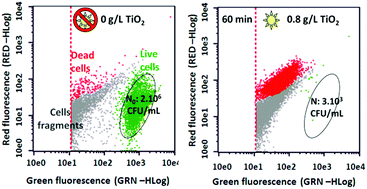The photocatalytic antimicrobial properties of TiO2 were studied on Staphylococcus aureus, Escherichia coli, and Pseudomonas aeruginosa bacterial strains taken as model strains for pathogenic species mainly implied in nosocomial infections. Capillary cytometry, coupled to a double-staining method for visualizing membrane integrity as a cell viability indicator, was highlighted as a rapid, easy-to-use, and automated numeration technique for quantitative and reproducible determination of cellular viability and thus, was able to give an accurate evaluation of the bactericidal effect of UV-A photocatalysis. Cytometry also enabled the study of TiO2–bacteria interactions and aggregation in the dark as well as TiO2 cytotoxicity. Compared with the traditional agar plate cultivation method, a significatively weaker reduction in cell viability was recorded by cytometry whatever the bacteria, TiO2 concentration, and duration of the photocatalytic treatment. The mismatch between both numeration methods was attributed to: (i) the presence of mixed bacteria–TiO2 aggregates that could interfere with bacteria measurement on plates, (ii) prolonged contact of the bacteria with TiO2 during incubation, which could cause additional cytotoxic damage to the bacterial wall, and (iii) the counting of viable but non-culturable bacteria as live bacteria in cytometry, whereas they cannot grow on solid media. A more pronounced difference was observed for P. aeruginosa and S. aureus bacteria, for which 2.9 and 1.9 log10 survival reduction overestimations were measured by plate counting, respectively. Using chemiluminescence, full restoration of cell viability by controlled addition of the O2˙− scavenger superoxide dismutase enzyme suggests that O2˙− acts, in our conditions, as the main reactive oxygen species responsible for the photocatalytic attack towards the targeted bacteria.


 Please wait while we load your content...
Please wait while we load your content...